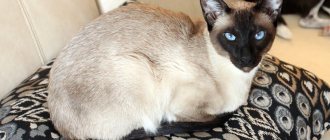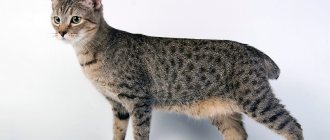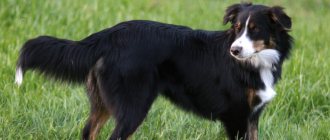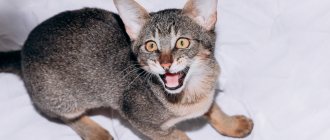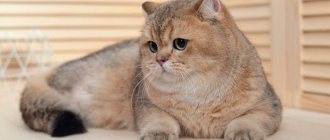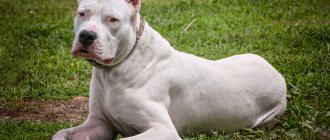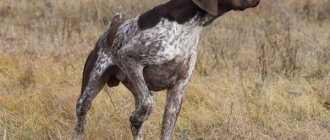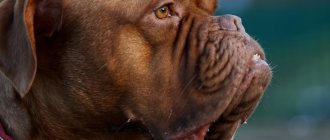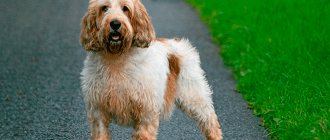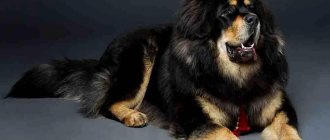Description and features
The cat is slightly larger than average in size, proportionally built, the body looks tightly “knocked together”. The coat is thick, soft and elastic to the touch, and fits tightly to the body. Reminds me of a plush cover. The colors are varied, there are shades of blue and red tones, multi-colored and one color.
The length of adult cats is 50-55 cm without a tail, height 29-32 cm. A cat's weight at 2 years can be 4.3-9.1 kg, and that of a cat 2.5-6 kg. Let us present to your attention a description of the cat based on the standard parameters.
- The head and everything that is on it can be called one definition - rounded. The muzzle, eyes, whisker pads - everything has soft rounded outlines, the skull itself is large, the chin is strong. The eyes are not only round, but large and wide open. The color may vary depending on the coat color.
- The nose is quite wide, but not long; the base is noticeable at the forehead.
- The ears, as the name implies, droop, taking on the appearance of a curved fold; the tip of the ear covers the pinna. They should be pressed tightly and not extend beyond the contours of the head. They may have one or two folds. From the tips to the earlobe you should get a small triangle with the apex at 90 degrees on the earlobe. In adult cats, a person's palm can easily be placed between their ears.
- The body is slightly elongated and looks graceful.
- The width of the hips follows the shoulders, the chest is voluminous.
- The legs can be of medium length or longer, strong, muscular, with round graceful paws.
- The tail is of medium length in relation to the size of the body, sometimes longer, mobile and flexible, tapering at the end. Typically, the longer and more tapered, the more expensive the cost of the animal. Ends with a round tip. A movable tail is valued, since deformities of the joints of this organ occur in the breed.
The Scottish Fold in the photo looks very much like an owl. Large and round eyes on a large head, a prominent nose and an attentive, slightly frightened look. And also dense fur, like thick down. And the ears are almost invisible. Here is such a “bird beast”.
Tabby colors
Scottish tabby cats are very popular among breed lovers. This color suggests the presence of patterns on the pet’s fur.
Depending on their shape and size, tabbies are divided into three types:
- Striped (tiger) color - the presence of clearly defined vertical stripes.
- Spotted (leopard) - the pattern is made up of spots on the animal's fur.
- Marble color is a pattern of larger chaotic marks of different shapes.
- cream;
- golden;
- blue;
- marble on silver;
- black marble;
- silver;
- silver-blue.
A prerequisite for tabby cats is the presence of the letter “M” on the top of the animal’s forehead. The color combinations of wool are surprising in their diversity:
Important: Scottish tabbies with a silver tabby color resemble the mustachioed pet from a cat food commercial. Many believe that it is the Scottish straight-eared cat with a tabby pattern that appears on the screen. This color is also called the whiskey color of Scottish cats.
Kinds
It happens that kittens of this breed have ears that remain straight as they age. Then they are called Scottish Straights. Many felinological (“feline” means cat) organizations recognize both of these species as one breed and are presented in the same ring.
The Scottish Straight standard is the same as the folds, except for the ears. In straight-eared animals, they should be small or medium in length, erect with pointed tips. Large at the base and set wide apart. The Scottish Fold color can be divided into several categories:
Classic solid colors, they are called “solid”, which means “strong, stable”:
- The Scottish Fold Black is a true jet black cat. No red tan marks are allowed, this is considered a defect. There may be a couple of white hairs on an anthracite background, but nothing more. A cat with eyes the color of chocolate caramel or dark honey. Very mysterious and effective. In the Scandinavian sagas it can be a companion of a sorceress.
- The Scottish White is a small snowman with bright eyes that can be blue, orange, amber or copper. And they also come in different colors (heterochromia). Kittens have faint spots on their fur; adult cats do not have them.
- Blue (blue color) implies several shades that are considered blue. Some have a color closer to gray, others closer to blue. All hair must be well dyed, then the fur looks the perfect color. Babies may develop small patterns on their fur that disappear after a couple of months. At first, the eyes may have a copper tint, but with age they turn a little yellow.
- Red (fawn) color is not common. A ginger cat from a young age has a color defect - an unevenly colored tail. Sometimes the color goes more red. Animals may have designs on their foreheads, but this is not considered a rule.
- Cream – creamy peach colored fur makes the cat very elegant and gentle. There are patterns on the paws and tail, but not in the form of leopard spots.
- Chocolate Scottish is a rather rare color and looks very beautiful. Kittens have pure chocolate-colored fur; adult cats have a noble bitter-coffee shade.
- Lilac (lavender) Scottish, you can also call it “coffee with milk”. Obtained only from parents of a similar color or. The eyes have all shades of honey - yellow, amber, orange, copper. Nose – beige or light brown.
- Faun (deer) - not to be confused with lilac. The color is a smoky fawn shade, with a chocolate tint on the folds. The nose and paw pads are soft pink.
- Cinnamon Scottish (cinnamon is a variety of cinnamon), the color looks like cocoa with the addition of cinnamon. It differs from chocolate in the bright pink color of its nose and paw pads with a brown tint. The color looks expensive, it is considered so, and it is also very rare.
Bicolor is a color of two colors, one is always white, the other is any of the solid tones. Pedigree cats must have a white face, paws, collar, chest and belly. It is appreciated if the white collar is not closed on the neck, and there is a spot in the form of a white triangle on the muzzle. Eyes of amber shades - bright orange, copper and honey color.
- Particolor (calico) - a combination of white and tortie (tortoiseshell) color, or white and spotted tabby color;
- Harlequin usually captivates at first sight with its elegant colors. The animal has 4/5 white fur, but the tail and ears, as well as the small cap on the head must be black. The belly is white, the nose has a pink tip.
- Van - only the tail is colored, and there are a few small spots on the head. If these spots have a red tint, the cat is called a “red van.” It is common that there are large solid spots on the paws and back, but breeders do not welcome this.
Color point is a rare color similar to the Siamese. On a light tone, darker points stand out - protruding parts of the body: ears, muzzle, tail and legs. The range of colors comes in chocolate, cream, purple, red and blue tones. Scottish cats “borrowed” this color from British cats. The eyes are bright blue, the more contrast, the more valuable.
Colo-point with white is an elite color. These animals look luxurious. In fact, this is a bicolor, only along with the white second shade there is a color-point range. The eyes, as is customary for color-point cats, are blue in different shades.
Ticked. Each hair of a cat's fur is colored in three colors. For example, a black ticked Scottish has light hair at the root, then brown, and black at the top. In this category there are red and blue ticked, black silver. Their eyes are orange-copper or green (usually silver).
Tabby - with bright stripes or spots on a light background. It comes in two types - classic (marbled) and brindle (striped). Kittens may have a pattern of the letter “M” or a butterfly on the back of their heads, and a pattern of rings on their sides, lighter or darker than the background;
Chinchillas are an artificially bred breed with a white undercoat, dark paw pads, and natural “makeup” on the face - a dark border around the eyes, nose and lips. The fur is not long, the colors are ticked and shaded. There are tortoiseshell (only cats), bicolor (expensive colors), smoky (both full and bicolor, van and harlequin). Relatively young breeds are popular - silver chinchilla and golden chinchilla.
Two-color
A unique coat color is bicolor (two-color cats). The main background is snow-white. The second color in color (cream, black, blue, red) is presented in the form of unusual patterns. Thoroughbred representatives must have white belly, neck, chest, paws, muzzle and beard.
A prerequisite is the predominance of a white background in color. Bicolors are more valued; their body patterns are symmetrical. The eyes can be any shade, but are usually blue or golden yellow.
Cream bicolor
Cute white cats with additional streaks of delicate cream tones. The eyes are blue or yellow, and the nose and pads are pink.
Blue bicolor
The pattern on the wool is blue (delicate or rich gray). The iris of the eyes is a beautiful sky tone or yellow-orange. The nose and paws below are pink.
Black bicolor
Black and white bicolor is characterized by patterns of rich black tone. These cats have a pink nose and blue or copper eyes. A symmetrical, distinct pattern on the skin turns the cat into a real gentleman in a tailcoat.
History of the breed
The ancestor of the Scottish Fold is considered to be a white cat named Susie. It was discovered on a farm near Cupar Angus in Perthshire (Scotland) in 1961. Susie's ears had an unusual curve in the middle, making her resemble an owl. The owner of the farm became interested in such an unusual appearance and decided to keep the cat.
Soon she calved, bringing three kittens with folded ears. One of them was purchased by neighboring farmer and cat lover William Ross. In 1966 he registered the breed with the Governing Council of the Cat Fancy (GCCF), a serious and established organization that has maintained a register of breeding cats in the UK since 1910.
From that moment on, the Scottish Fold breed . Geneticist Pat Turner helped him. In the first three years of the program, 76 kittens were produced, 42 of them with folded ears, 34 with straight ears. It turns out that the famous ear is the influence of a dominant gene, a mutation process.
The first cat with such “wrong” ears, as it was believed, was the ancestor of the world-famous breed. In 1971, the breed was introduced to Europe, but it was not accepted, so the GCCF withdrew its registration. There were many reasons - scientists thought that some cats had deformities in their limbs and tails, which they mistook for a deformity.
There have also been comments about genetic difficulties and ear problems such as infection, mites and deafness. But enterprising Americans purchased cats with folds on their ears, and the breed has already begun to spread throughout the world. American Scottish folds and European ones appeared.
Subsequently, the Scottish Scottish Fold was crossed with the British Shorthair and American Shorthair. By the way, after the first complaints, the breed did not have problems with mites and infections, although these cats may have more wax discharge in the ears than others.
Chinchilla
The Scottish chinchilla borrowed the extravagant colors of its coat from the British, and they, in turn, from Persian cats. A chinchilla kitten is born only from parents with an unusual color. Each hair is colored in two colors.
Most of it is light in color and 1/8 of it (the top) is dark in color. This phenomenon is called tipping.
Tipped chinchilla colors can be of 3 types:
Character
The character of the Scottish Fold is calm, accommodating and sociable. The animal is not capricious, unpretentious in everyday life, and behaves balanced. It becomes very attached to its owner and its habitat. Doesn't like to attract attention to himself by meowing. What needs to be especially noted here is the cat’s voice.
It doesn't sound like a normal purr, it sounds slightly like a cold, even squeaky. It is clear that the cat does not really like to bother someone. These cats have a very interesting feature - they calmly stand on their hind legs.
They simply stand up and look at what interested them, but was difficult to see from below. Some can even stand like this for a long time, reminiscent of desert animals - meerkats. They also sleep comfortably on their backs. Scottish Fold kittens are cheerful, affectionate, playful, get used to being handled, and can be trained.
They can often be seen at various performances. They quickly get used to the scratching post. Good companions for both adults and children. They don't like noise and can get scared. If you have a small child, it is better to adopt a pet at the age of 3-4 months. They are already socially adapted and understand the basics of independent living.
I would like to note the innate nobility of these animals. Their presence has a positive effect even on dogs, although cats and dogs are usually two irreconcilable categories. And a few words about his delicacy. The cat cannot stand loneliness, but you may not even notice it. He will very tactfully and quietly settle down somewhere nearby.
How to choose a kitten
You should not buy a fold-eared kitten under 2.5 months. By this age, the ears have already formed, the kids have acquired the necessary skills and are ready to move.
Kennels breed Scottish Folds. You should not buy mixed breeds - health and character can be unpredictable. You will only become attached to your pet when serious chronic problems are discovered. Purebred Scots have all the positive qualities of the breed.
The main problem for Scots is joint dysplasia (JD). This is a serious disease of the joints and spine. By buying a cat from a trusted breeder, you protect yourself and the animal from problems. However, the American Cat Fanciers Association CFA advises to always check a kitten when purchasing:
- Determine the flexibility of the tail. To do this, very quickly move along it with a light, slightly curving movement towards the end. There is no need to bend or break the cat's tail.
- Check the paws, they should bend at all joints.
- Watch how the kitten moves. There should be no hint that unnaturally short, stiff legs interfere with his walking.
Pay attention to active kittens. Ask about the age of the mother - mating in cats is allowed only after the fourth heat. Look at the kitten vaccination passport: at this age it should already be carried out.
Over time, the color and eyes will become brighter. The coat may be slightly paler than the mother's, but it should be evenly colored.
The cost of a Scottish fold kitten starts from 10,000 rubles and depends on whether you need a show breed or show-class cat or just a pet.
Nutrition
You can choose natural food for feeding - boiled lean meat (chicken, beef), as well as raw meat (kittens need to be finely chopped or given minced meat), chicken and beef offal (for dark breeds), boiled sea fish, boiled egg yolk, cottage cheese , kefir and other lactic acid products, cereal porridges, sprouted grains of oats and wheat.
Add vitamins, minerals, calcium and stomach hair removal paste. Sometimes give your cat brewer's yeast, dried kelp, fruits or vegetables. These are sources of vitamins and fiber. You can feed them with ready-made premium food or on a natural basis. Don't forget about clean drinking water.
What to feed?
To keep your pet happy and healthy, you need to carefully monitor its diet. If the owner plans to feed the cat natural food, then his diet should include the following products:
- meat (beef, turkey, veal);
- boneless fish;
- offal (boiled);
- vegetables;
- eggs.
It is not recommended to feed cats raw, unprocessed meat to avoid infection with helminths. Also, do not give your pet milk. It is useful only for small kittens, but not for adult animals.
Products prohibited for cats include:
- sweets;
- alcohol;
- fatty and fried foods;
- smoked meats
Such food is not only not healthy for the animal, but can also have a detrimental effect on its health and body function.
If the owner decides to feed the pet prepared food, then preference should be given to well-known premium companies, such as Royal Canin or Purina. Scottish Folds happily eat both wet and dry food.
Your cat should always have a bowl of clean, fresh water.
Reproduction and lifespan
A Scottish Fold cat is allowed to be bred no earlier than two years of age. They are bred only with “straight” cats, and vice versa, “fold” cats with straight-eared cats. To pair a “fold”, they select not just any straight-eared breed, but a descendant of a similar mating.
This helps to avoid hereditary bone abnormalities that occur when mating two “folds”. By the way, our “fold” also does not need to be crossed with the British, there may be kittens that do not fall under the standard. Both producers must be healthy and vaccinated. Mating takes place only on the cat’s territory or in any convenient place.
But not in the cat's house. As soon as the gentleman has lost interest in the lady, you can take the cat home. The first month of pregnancy of the visloushka passes unnoticed by anyone. Pay attention to her feeding. If you fed your cat ready-made food, switch to kitten food. There are manufacturers of food specifically for pregnant cats.
In the second month of pregnancy, the cat needs to be fed 3 times a day. Prepare her birth box and introduce her to it. Let her get used to the “children's house”. Pregnancy lasts 60-65 days, maybe a little more. Don't be alarmed if your kitty tolerates a little. Childbirth lasts about a day. Keep an eye on her, she needs your attention.
Yes, and to avoid trouble. There can be from 1 to 6 kittens, but usually 3-4. In each litter, cats can have both “folds” and “straights”. For the first two weeks, you don’t even have to remember about them; the mother cat does everything. She washes them, feeds them, warms them, cleans them. Then they begin to crawl, by the 4th week they can begin to be fed with fermented milk products, soaked food or finely chopped meat.
By the end of the 4th week they will start to climb out of the box, it's time to show them the litter box. These animals are a real joy in the home, and it is important that they live longer. With normal care, feeding and care, pets live up to 10-15 years.
What do Scottish Fold cats suffer from?
Scottish Folds are quite healthy. However, there are several diseases that are genetically characteristic of this breed.
- Osteochondrodysplasia (OCD) is a malformation of cartilage and bone tissue, which leads to a slowdown in their growth. This disease is considered incurable, so only supportive therapy is prescribed.
- Polycystic kidney disease (PKD) is a disease in which many hollow tumors with liquid contents (cysts) form in the kidneys. As a result, the affected organs do not fully perform their function.
- Cardiomyopathy is a disease in which the normal functioning of the heart muscle is disrupted.
Also, Scottish Fold cats can suffer from diseases that are typical for most purring pets. These include problems with the genitourinary system, skin and other diseases.
Find out the secret
